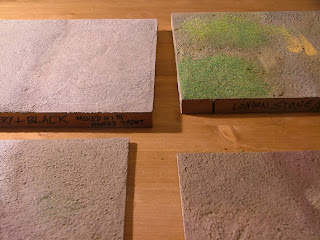It's pretty straightforward in principle. Cut out a piece of MDF, create some texture with Polyfilla, paint and sprinkle on static grass. But in the event, I made a few false starts before getting something I was happy with.
To start with, I had planned to use 3mm MDF and simply drop this in on top of the green baize. But when I tried it the problems soon became very evident. The polyfilla and paint made the MDF buckle, and the thickness of the acrylic cover meant that you could see the edges. In the end, I took out the original base and cut another one from 6mm MDF, which the acrylic cover would sit on.
Next, the Polyfilla. This was quite easy. I just smeared it on with a trowel, then went over it with a coarse-textured sponge. This removes the ridges and gives a nice granular look.
 |
| Nothing but the best for my airfield |
Now for the paint. My friend Matt (of Wargames Table fame) had kindly lent me some Vallejo acrylics, which have worked well for him. But once I started thinking properly about this part of the project, I started having ideas of making much larger bases at some point (more about that in the future maybe) - and so decided it would be more economical to use emulsion. Having made that decision, I slightly undermined my economic rationale by going for very expensive emulsion paint that is more often seen on the walls of Georgian houses in Bath than on representations of French meadows in April 1918. But Farrow and Ball does dry to a fantastic matt finish; and, more importantly, it comes in many shades of brown. Conceivably, it will do a Northern French Soil Brown in a future range.
Anyway. I had a few sample pots lying around and so I did a bit of experimentation with them, on spare scraps of MDF that I had prepared. I have to say, the results were not very impressive at first. One of the samples would have looked great in an El Alemein diorama, and another one would be just the job for Apollo 11. It turned out that none of the paint samples I had were much of a soil colour and so I ended up mixing them. Here are some of the results.
The formula I ended up with was as follows: a base coat of London Stone blended with London Clay and India Yellow; followed, when dry, with a lighter mix of the same colours. And this, with some static grass, is the result:
And here it is after the Dolphin has landed:
And that's about if for my Dolphin for the moment. If only it could talk, I feel sure it would have some appropriate valedictory statement. As it is, I will just say bye for now, and thanks for looking at my posts.
...
Having said that, I am starting to think about what I'm going to work on next. I haven't decided yet, and it might be some time before I get round to it, but it may well be another Sopwith, and it may well involve a fraction.




Thanks (sorry for late reply). I'm starting to mull over my next project so more posts this year, hopefully.
ReplyDelete